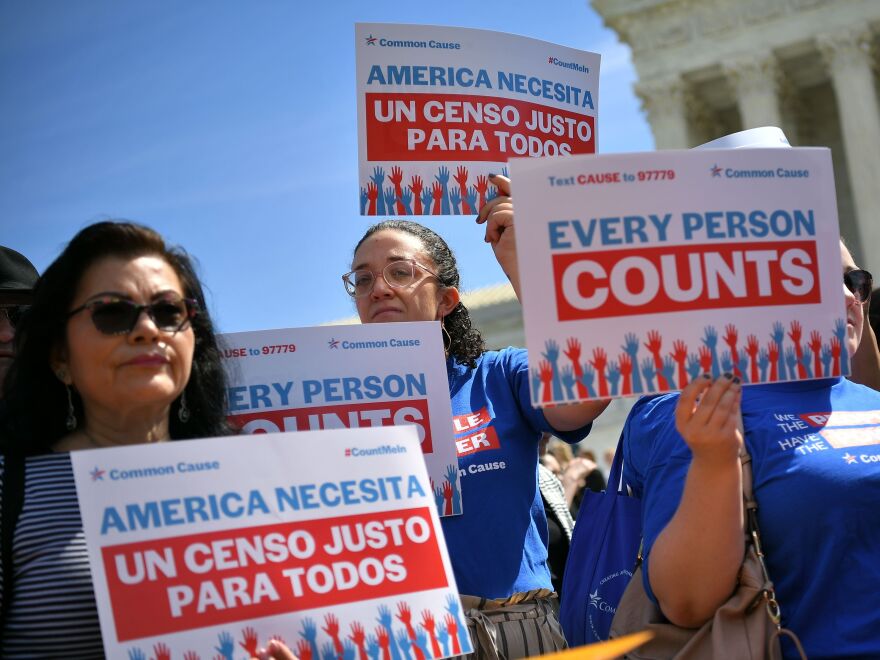Updated @ 4:12 PM EDT on August 8, 2025
President Trump announced on Thursday that he has directed his staff to begin work on a “new” census, even though the 2030 census preparations are already under way.
Trump claimed on social media that the census would leave out millions of individuals who are not citizens, which would be a first for the nation’s population counts since the first U.S. census was taken in 1790.
The “whole number of persons in each state” must be included in a crucial set of census data used to elect presidents and members of Congress, according to the 14th Amendment.
No information on the strategy has been made public by the Trump administration. As a result, many things are unclear, like whether Trump is referring to the regularly scheduled national head count in 2030 or an earlier count, as the Constitution states that Trump does not have final authority over the census.
In order to “immediately begin work” on a census, Trump said he has directed the Commerce Department, which is in charge of the Census Bureau, to use “the results and information gained from the Presidential Election of 2024.” Why the census might be affected by the election outcomes is unknown.
NPR’s requests for comment were not answered by the White House press office.
“The Census Bureau will immediately adopt modern technology tools for use in the Census to better understand our robust Census data,” the Commerce Department stated in a statement. In order to appropriately represent the number of lawful residents in the US, we shall accurately examine the data.
The Constitution did not grant a president final authority over the census
Congress, not the president, is empowered by Article 1 of the Constitution to conduct the “actual enumeration” of the nation’s population in “such manner as they shall by law direct.” Congress instructed the secretary of commerce to conduct a census once every ten years in Title 13 of the U.S. Code.
The commerce secretary may carry out a mid-decade census in 2025 in accordance with that same rule, but the results cannot be utilized to redistribute the number of seats and votes each state has in the US House of Representatives and the Electoral College. Additionally, Congress would have required to be notified years ago of the question themes for such a census in 2025.
Even though the Constitution mandates a census every ten years in order to redistribute congressional seats once every ten years, it’s unclear if a head count may be carried out in a different year. The results would then be used to re-allocate each state’s share of Electoral College votes and House seats.
Rep. Marjorie Taylor Greene, a Republican from Georgia, sponsored a Housebill last month that seems to be in line with Trump’s call for a fresh census. That law proposes a fresh census and round of congressional redistricting before to the 2026 midterm election, in addition to removing noncitizens from the apportionment figures.
In July, when asked about the bill, Trump stated, “It will be enacted.” It will pass, and we will be extremely content.
Other Republicans in Congress have proposed measures this year that would exclude from the regularly scheduled 2030 apportionment counts either individuals without legal status or all individuals without U.S. citizenship, including those with green cards.
Trump’s remarks about the census on Thursday also follow his outspoken calls for Republicans in certain states to redistrict in an effort to gain additional seats in the US House. Democrats in other states are contemplating possible reactions, including their own partisan gerrymandering, in response to the GOP’s bid to redraw the congressional map in Texas, which has sparked a nationwide political struggle.
In a statement, National Democratic Redistricting Committee President John Bisognano said, “It is no coincidence that President Trump wants to manipulate the census data at the same time he is pressuring Republican states to gerrymander even more.” “This is a comprehensive campaign to flout the U.S. Constitution in order to predetermine election outcomes so he can consolidate his power and avoid accountability to the American people.”
The American Civil Liberties Union, one of the organizations that spearheaded legal actions against Trump for his unsuccessful attempts to alter who was counted in the 2020 census, hinted that another legal dispute would be imminent just hours after Trump’s statement. According to a statement from the ACLU’s Voting Rights Project director Sophia Lin Lakin, any effort by the Trump administration to bar undocumented U.S. citizens from a census “would defy the Constitution, federal law, and settled precedent.”
“We won’t hesitate to go back to court to protect representation for all communities,” Lakin stated.
According to legal experts, if Trump is talking to the 2030 census, Congress or his successor may have the chance in 2029 to remove any additional questions regarding an individual’s immigration status before they are printed on paper forms for the census.
To prepare for the census, the Census Bureau is currently engaged in a multi-year process. The first version of its operational plan for that count was revealed last month, and it is expected to begin hiring temporary workers this fall to conduct the “2026 Census Test,” a significant field test for its 2030 plans that will be conducted in six South and West regions.
Trump’s request for a census “using the results and information gained from the Presidential Election of 2024” raises questions about the accuracy of the data the federal government generates, according to Meeta Anand, senior director of census and data equity at the Leadership Conference on Civil and Human Rights, just days after he fired the commissioner of the Bureau of Labor Statistics for releasing a weaker-than-expected jobs report.
“To me, that represents an attempt to undermine and sow doubt on existing data and to raise the specter of manipulating data going forward,” adds Anand. “It’s all part and parcel of the same playbook of telling people not to believe what is existing already and what has been collected and tabulated and reported in accordance with scientific standards and principles, and instead to believe what is being put in front of them without evidence for the purposes of political gain.”
Trump’s 2020 census bid to exclude people without legal status was stopped
Trump’s most recent initiative revives his first administration’s initiatives. The U.S. Supreme Court eventually blocked the inclusion of a question regarding a person’s U.S. citizenship status on 2020 census forms, but it declined to decide on whether the president may, for the first time in American history, remove those without legal status from apportionment tallies.
With a 2021 executive order, former President Joe Biden upheld the long-standing custom of factoring in the overall population of the states in such counts. Trump reversed this order on the first day of his second term.
The Census Bureau has not yet tested using the census to inquire about an individual’s immigration status.
However, the bureau’s study indicates that asking “Is this person a citizen of the United States?” using the federal government’s once-every-ten years census is likely to result in inaccurate self-reported statistics and deter many families with Asian American or Latino members from being counted. Federal financing for public services in localities around the nation is also divided by population totals.
Additionally, the bureau’s researchers have cautioned that developing a new census question to generate neighborhood-block level citizenship data would be “very costly,” degrade the quality of other demographic statistics the census generates, and result in “substantially less accurate” data than what is currently available from government records regarding people’s citizenship status.
The Supreme Court concluded that the first Trump administration’s claim that a census citizenship question would improve the enforcement of racial minority groups’ right to vote was “contrived.”
Trump consequently issued an executive order in 2019 outlining additional justifications for generating citizenship statistics, which would be more thorough than the estimations the bureau now publishes. These included determining the number of individuals in the United States without legal status and influencing immigration policy and eligibility requirements for public services. The judgment also permitted state and local governments to create voting districts that do not take into consideration non-citizens and children. “Advantageous to Republicans and Non-Hispanic Whites,” according to a 2015 analysis by a Republican redistricting strategist, would be the conclusion of that drastic divergence from modern normal redistricting processes. Before the Supreme Court, its legality is up for debate.
A presidential memorandum for 2020finally validated a second objective for Trump’s initial campaign for a citizenship question data that would permit the historic exclusion of undocumented immigrants from congressional apportionment tallies.
Census records dating back to 1820 demonstrate that Trump’s proposal defies centuries of precedent, despite the fact that officials in the first Trump administration frequently stressed that previous national head counts had inquired about people’s U.S. citizenship status in some capacity. Never before has the federal government directly inquired about the citizenship status of every individual residing in every American home during the census.
Benjamin Swasey edited it.
Copyright 2025 NPR






